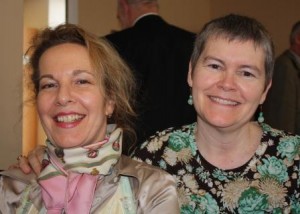The Collaborative Family Law Group (CFLG) is a Victoria-based interdisciplinary group of independent professionals, whose mission is to encourage and promote a new process to create positive solutions for people in conflict and families in transition. Indeed that’s why I’m a fan of theirs.
Recently I attended, as a guest, one of the regular monthly CFLG meetings. I also engaged in conversation two members of the group; Elise Schopper-Brigel, lawyer and CFLG co-chair, and Mary Mouat, lawyer and chair of the Law Foundation of British Columbia. Here’s what I discovered.
The CFLG team
The CFLG approach is a team-oriented systems/holistic approach to service delivery. Typical clients are divorcing couples, with/without children.
The CFLG includes counsellors (e.g., divorce coaches), psychologists (e.g., child specialists), financial specialists (e.g., business valuators, certified financial planners, accountants), social workers, and lawyers (many of whom also work as mediators), all of whom are committed to the collaborative law process. There are about 50 professionals in total, approximately 2/3 are lawyers.
The CFLG builds on the vision of the godfather of collaborative law, Stu Webb (check out this interview of Stu Webb, on YouTube, in which he talks about his ahah! moment in 1990 and the genesis of his collaborative law practice). BC mediator/lawyer Nancy Cameron is a leading local proponent of collaborative law, and another major influence for the CFLG (I read and highly recommend Nancy’s book Collaborative Practice: Deepening the Dialogue, a road map for family lawyers making the journey from traditional litigation to collaborative practice thanks to Mary for the heads-up on this book). The importance of systems approaches I previously touched on in it takes a system to change a system.
How it works
The CFLG is free-standing group; e.g., not part of the BC Bar Association. Members agree to, and are accountable to, a set of values, protocols, and rules. Each member also has a professional life outside of the group, be it a private practice or as part of another practice group.
Working on a team concept, CFLG professionals come together based on client needs. Collaborative law is an out-of-court process. (Note: Corporate law has incorporated collaborative approaches for years. CFLG has added the other pieces, e.g., coaches, that are crucial to resolving the issues that come with long-term family relationships.) The work is coordinated by an executive, and supported by administrative staff.
Keeping everybody on the same page
Each CFLG member renews their yearly commitment to CFLG by:
- Paying an annual membership fee
- Attending one major training event / year
- Participating on a CFLG committee; e.g., protocol, marketing
- Meeting once/month as a group (note: CFLG executive also meets once/month on their own)
Ongoing dialogue is central to the group; e.g., dialogue on what collaboration means.
Members are expected to be mindful, keep judgements at bay, check out all assumptions, appreciate diversity of membership (the more diverse the membership, the stronger the group), and stay responsive to the different constituencies (within the group and also among clients).
Being responsive and adaptive to the local scene is important. No two collaborative law practice groups are the same. Basically, CFLG members sign on with intention, to be authentic, and to represent the values of collaborative practice as best as they can.
What’s next
From what I see the CFLG is a progressive, vibrant group, with committed members.
Still, as Elise points out, though collaborative law resonates with today’s zeitgeist, it has yet to reach a tipping point with the public. People are looking for more than adversarial approaches to conflict resolution. The CFLG wants to be as top of the mind as mediation. Looking ahead, CFLG intends to increase use of social media, hone individual member marketing skills (a good thing for any organization/association to do, I’d say!), and tell the collaborative law story more.
Question
To the reader, what collaborative group/organization are you familiar with; that reflects a positive break from tradition (such as lawyers move from litigation to collaborative practice)?
If you enjoyed this post, please consider leaving a comment or subscribing to my blog. Thanks, Ben.


Thanks for the content.